Overview
Functional ab training emphasizes exercises that activate the entire midsection, thereby enhancing overall stability, strength, and functional movement patterns—key components for both athletic performance and daily activities.
Research underscores the effectiveness of stability exercises in bolstering core strength and mitigating injury risk, especially for individuals over 50.
This highlights the extensive benefits of incorporating functional ab training into fitness routines, making it a vital element of any comprehensive wellness program.
Introduction
In the quest for optimal fitness, the significance of core strength takes center stage. However, many still cling to outdated notions about abdominal workouts. Functional ab training emerges as a game-changer, focusing on exercises that engage the entire core and mimic real-life movements, rather than isolating specific muscles. This holistic approach not only fortifies stability and strength but also enhances everyday performance, posture, and balance. As misconceptions about spot reduction and aesthetic-driven workouts persist, understanding the true purpose and benefits of functional core training becomes crucial.
From improving athletic capabilities to preventing injuries, the advantages of a well-rounded core regimen are profound. This makes it an essential component of any fitness journey. With expert insights and evolving methodologies, this exploration delves into the transformative power of functional abdominal workouts and how they can be seamlessly integrated into diverse fitness routines.
What is Functional Ab Training?
Functional ab training emphasizes exercises that engage the entire midsection—including the abdominal muscles, obliques, and lower back—to enhance overall stability and strength. This approach diverges from traditional ab workouts, which often isolate specific muscles, by focusing on movements that replicate real-life activities. Such a method not only strengthens the foundation but also improves posture, balance, and coordination, making it an essential component of a comprehensive fitness regimen.
Recent findings underscore the effectiveness of stability exercises. Research reveals that the average relative thickness of central muscles—such as the transversus abdominis (Tra), internal obliques (IO), and lumbar multifidus (LM)—is significantly greater when employing the hollowing technique compared to the bracing maneuver (p < 0.001). As noted by Daniel Jerez-Mayorga, a postdoctoral researcher, "This study has been partially supported by FEDER Agencia Andaluza de Conocimiento- Andalucía 2014-20/ Consejería de transformación económica, industria, conocimiento y universidades (B-CTS-184-UGR20)." This insight indicates that integrating diverse fundamental exercise approaches can enhance athletic performance and functional strength.
Moreover, foundational training yields substantial benefits in daily activities. Individuals who engage in functional exercises report improved performance in tasks requiring stability and strength, such as lifting, bending, and even walking. This is particularly advantageous for men over 50, as maintaining essential strength is crucial for preventing injuries and enhancing overall mobility.
Practical examples illustrate the advantages of functional strength exercises. Athletes who incorporate stability exercises into their routines often experience significant enhancements in jumping performance, with studies showing moderate to large effects on both vertical and horizontal jumps. Such improvements not only aid in athletic achievement but also translate into daily physical activities, making foundational exercises a worthwhile investment in one’s health.
As the fitness landscape evolves, expert opinions increasingly highlight the significance of functional ab training. Fitness professionals advocate for a comprehensive method that integrates functional ab training with stability exercises, underscoring their importance in improving overall physical performance and well-being. The variability in fundamental exercise approaches, as emphasized in the case study titled "Fundamental Exercise Methodology Variability," indicates that despite differences in frequency, duration, and intensity, such exercises generally lead to enhancements in athletic performance.
By prioritizing functional training of the body, individuals can cultivate a stronger, more resilient physique capable of thriving in both athletic and daily environments.
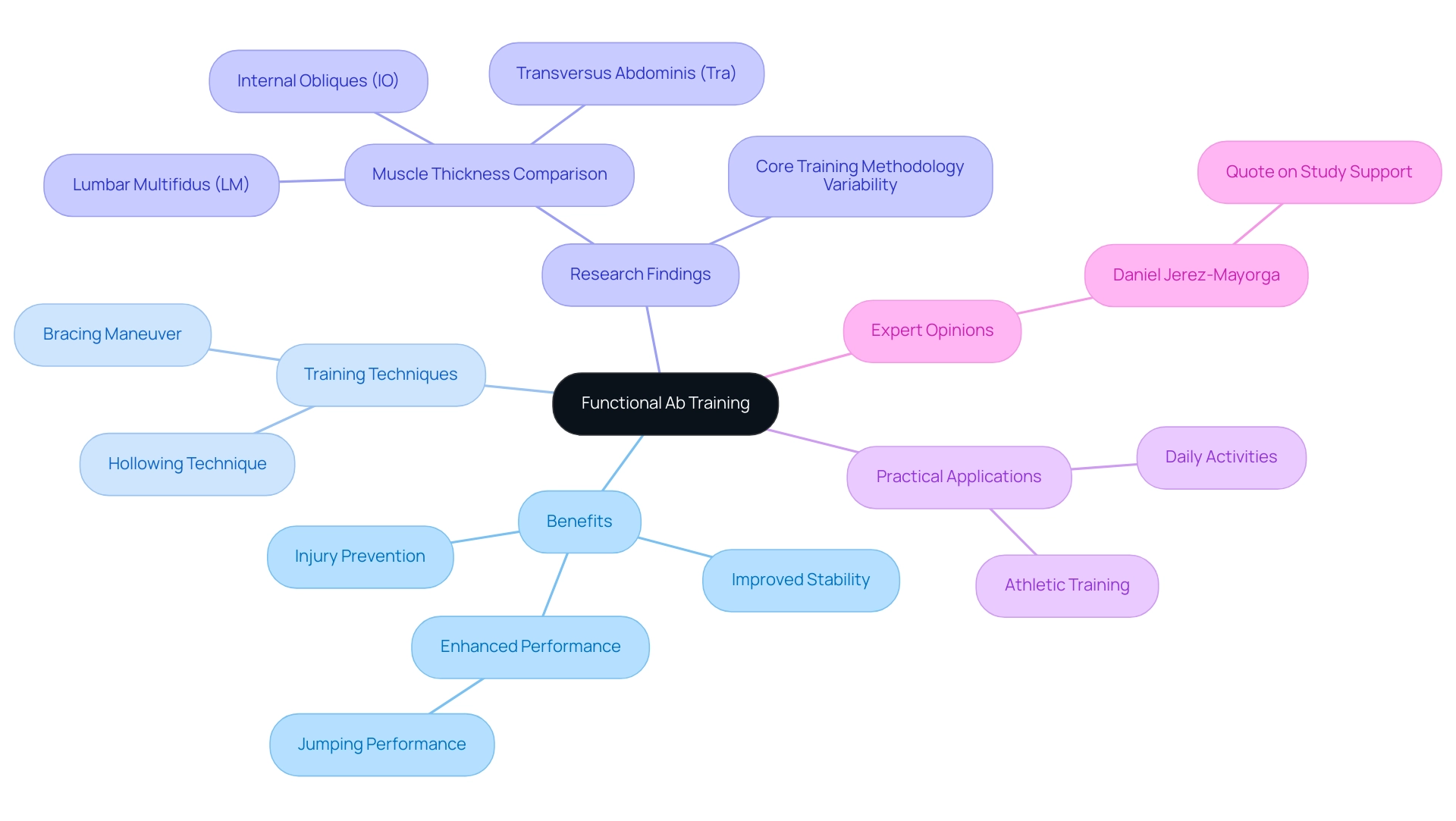
Debunking Myths: Common Misconceptions About Ab Workouts
Numerous misconceptions persist regarding ab workouts, particularly the notion that performing endless crunches will yield visible abs or that spot reduction of fat is achievable. In reality, achieving a toned midsection requires a comprehensive strategy that merges overall fat reduction through a balanced diet and regular exercise with focused abdominal strengthening exercises. Research indicates that a significant percentage of individuals still believe in the myth of spot reduction, despite evidence suggesting that fat loss occurs uniformly across the body rather than in isolated areas.
Furthermore, many people mistakenly associate central exercises solely with aesthetics. However, functional ab training plays a crucial role in enhancing athletic performance and preventing injuries. Fitness specialists stress that effective functional ab training should focus on stability and strength rather than just aesthetics.
Kia Williams notes that traditional crunches may not be the most beneficial for building functional strength, as they can lead to unnecessary compression on spinal discs due to repetitive forward flexion. This emphasizes the necessity for a transition towards more practical movements in functional ab training.
Disproving these misconceptions is crucial for individuals looking to enhance their exercise strategies. A case study on the significance of internal muscle conditioning emphasizes that while many link abdominal exercises with outer muscles, the inner muscles are essential for offering stability and support to the body. Maintaining a strong inner foundation is crucial for overall health, facilitating proper breathing, and enhancing physical stability, particularly during activities that require balance and coordination.
In addition, physical activity can greatly enhance job performance, creativity, and stress management, emphasizing the significance of including fundamental workouts in a holistic fitness plan.
In conclusion, recognizing these prevalent misconceptions about abdominal workouts enables individuals to focus on efficient methods that foster overall fitness and wellness, instead of being deceived by antiquated notions. Even minor levels of physical activity, like walking, have a positive impact on cardiovascular health, demonstrating that all types of exercise, including strength workouts, are advantageous. Additionally, fundamental training is essential for various demographics, including pregnant women, as it helps alleviate discomfort, improve posture, and enhance functional strength throughout pregnancy.
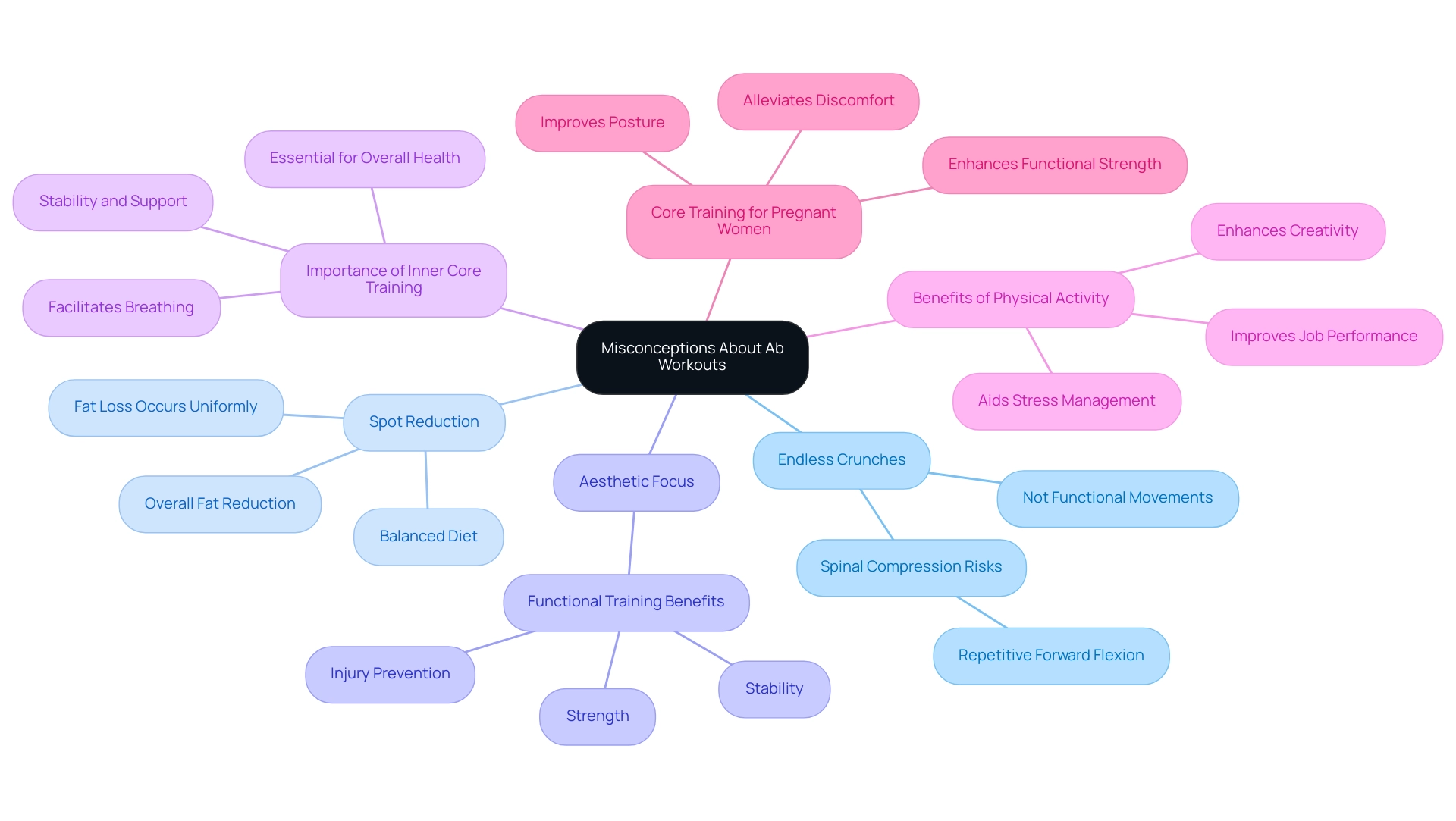
The Purpose and Benefits of Functional Abdominal Workouts
Functional ab training is vital for boosting trunk strength, stability, and movement patterns, collectively enhancing athletic performance. Engaging in functional ab training not only fortifies the center of the body but also minimizes the chance of injury and encourages improved posture. Research indicates that individuals who consistently participate in fundamental physical activities experience substantial enhancements in their athletic abilities, as these routines involve various muscle groups, resulting in improved functional strength for everyday tasks.
Statistics from a study by McGill & Masrshall (2012), involving participants aged 25.60 ± 3.40 years, reveal that effective foundational conditioning can lead to a significant reduction in injury rates among athletes. The study calculated effect sizes using a random-effects model, providing a robust framework for evaluating the effectiveness of fundamental activities. This classification emphasizes the significance of varied training techniques in optimizing muscle activation and fitness results.
Expert opinions further support the notion that functional ab training is essential for injury prevention. Dr. Terence Dwyer, a lead researcher at the University of Oxford, emphasizes that increasing exercise intensity can significantly lower heart disease risk and enhance overall health. This viewpoint aligns with results that connect fundamental strength to lower injury rates, particularly in high-impact athletics.
Furthermore, Foresight Health Coaching's corporate alliance provides organizations an opportunity to foster a healthier team culture through functional ab training exercises. By implementing core training programs, HR Benefits Managers can enhance employee wellness initiatives, leading to improved organizational performance and reduced absenteeism.
Real-world examples illustrate the transformative effects of core training on athletic performance. Athletes who incorporate functional ab training into their routines often report enhanced agility, balance, and endurance—qualities essential for competitive success. Moreover, these exercises foster motivation and engagement in fitness routines, encouraging long-term adherence and overall success in achieving fitness goals.
In summary, the benefits of functional ab training extend beyond mere aesthetics; they play a pivotal role in enhancing athletic performance, preventing injuries, and promoting a healthier lifestyle. By prioritizing essential strength, individuals can unlock their full potential in both sports and daily activities, while organizations can reap the rewards of a healthier, more cohesive team.
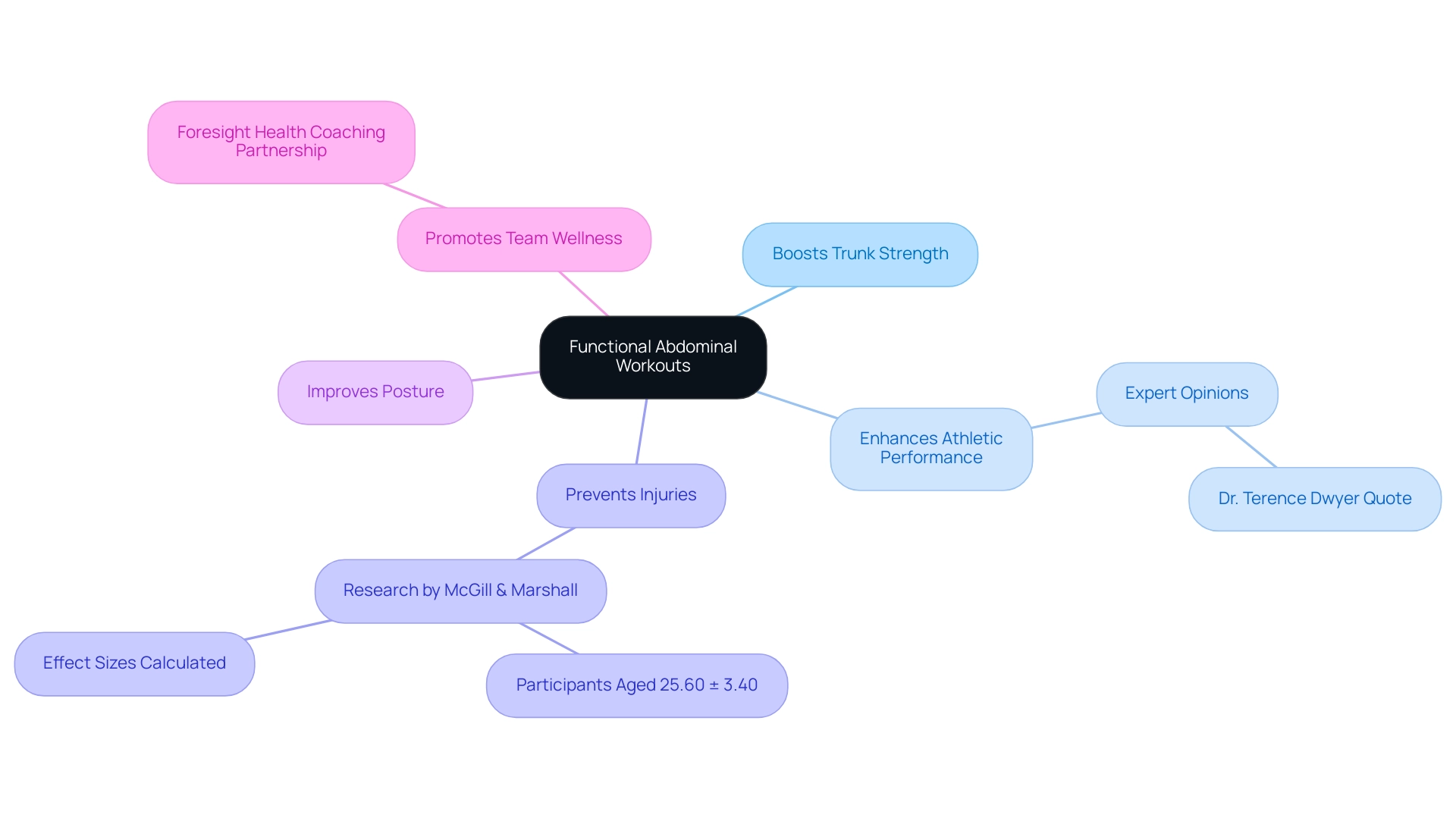
Designing an Effective Functional Ab Workout
An effective functional ab training routine should encompass a diverse range of activities targeting various areas of the midsection. Essential components of functional ab training include:
- Planks
- Dead bugs
- Russian twists
These exercises engage multiple muscle groups and enhance stability. Incorporating both static and dynamic movements is vital for a comprehensive approach to functional ab training, as this combination boosts overall strength and functionality.
To sustain engagement and prevent plateaus, it is crucial to vary the intensity and complexity of workouts. For instance, a systematic review analyzing EMG activity from 1,247 healthy participants across 67 studies highlighted that movements like the curl-up and various stability routines significantly activate the rectus abdominis, underscoring their effectiveness in functional ab training. Notably, participants in the McGill & Marshall (2012) study had an average age of 25.60 ± 3.40 years, providing context for the efficacy of these exercises across different age groups.
Moreover, a well-structured routine must be tailored to individual fitness levels and goals, allowing for necessary modifications. This personalization not only maximizes the effectiveness of the exercise but also fosters a sustainable fitness journey. Our wellness coaching app, Corporate Membership - Contact Our Health Coaches Today, enhances this experience by offering personalized workouts, nutrition guidance, and daily programming to help users achieve their health goals efficiently.
The convenience of having all wellness resources in one place ensures that users can easily access everything they need to succeed. Additionally, the app features direct messaging with coaches for personalized support and community engagement, further motivating users on their fitness journey. As fitness coaches emphasize, essential workout routines should blend fundamental exercises with creative variations to guarantee ongoing progress and involvement.
As Daniel Jerez-Mayorga, a postdoctoral researcher, noted, "This study has been partially supported by FEDER Agencia Andaluza de Conocimiento- Andalucia 2014-20/ Consejería de transformación económica, industria, conocimiento y universidades (B-CTS-184-UGR20)." By integrating effective fitness programs through our app, organizations can cultivate a healthier team culture, aligning with the objectives of HR Benefits Managers.
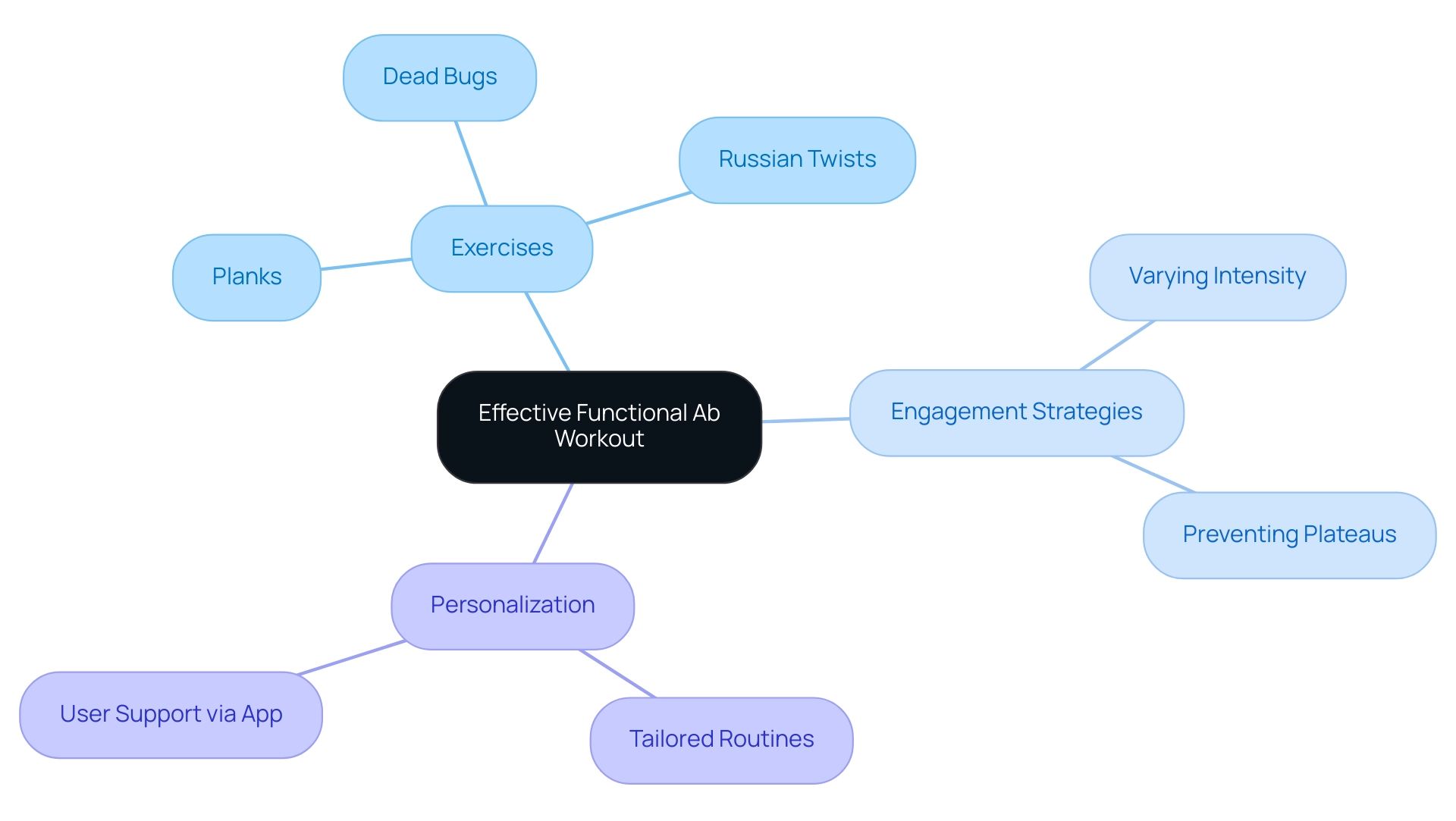
Integrating Functional Core Training into Your Fitness Routine
Incorporating functional ab training into your fitness regimen is essential for enhancing overall performance and preventing injuries. This training seamlessly integrates into various exercise modalities, including strength training sessions, cardio routines, and even yoga practices. For instance, incorporating fundamental routines at the start or finish of a workout ensures that the central muscles remain actively engaged throughout diverse movements.
Focusing on stability during compound exercises, such as squats and deadlifts, not only improves form but also maximizes the effectiveness of these movements. This holistic approach strengthens the foundation while enhancing functional movement patterns critical for daily activities.
Research indicates that fundamental exercises significantly impact balance, with a substantial effect size noted in studies (SMD = 0.81; 95% CI: 0.34–1.27; I = 0%; p = 0.0006). Such enhancements in balance can lead to improved athletic performance and a reduced risk of injury. Furthermore, trainers underscore the importance of stability in workouts, highlighting its potential to enhance skills in specific athletic activities, such as throwing, as noted by Manchado et al.
However, it is crucial to recognize that further research is necessary to fully comprehend the influence of fundamental exercises on athletic skill performance, as the existing evidence presents moderate to low quality regarding its effects. This was emphasized in the case study titled "Risk of Bias and Quality Assessment," which evaluated the quality of evidence across various studies.
Practical examples illustrate the advantages of integrating fundamental exercises into fitness regimens. Numerous athletes and fitness enthusiasts report improved performance and reduced fatigue when foundational exercises are consistently included in their routines. As the fitness landscape evolves in 2025, the focus on functional ab training remains a cornerstone of effective strength training, highlighting its role in fostering resilience and enhancing overall physical capabilities.
Additionally, organizations are encouraged to invest in their teams' health, as this not only cultivates a stronger team culture but also enhances overall performance and well-being.
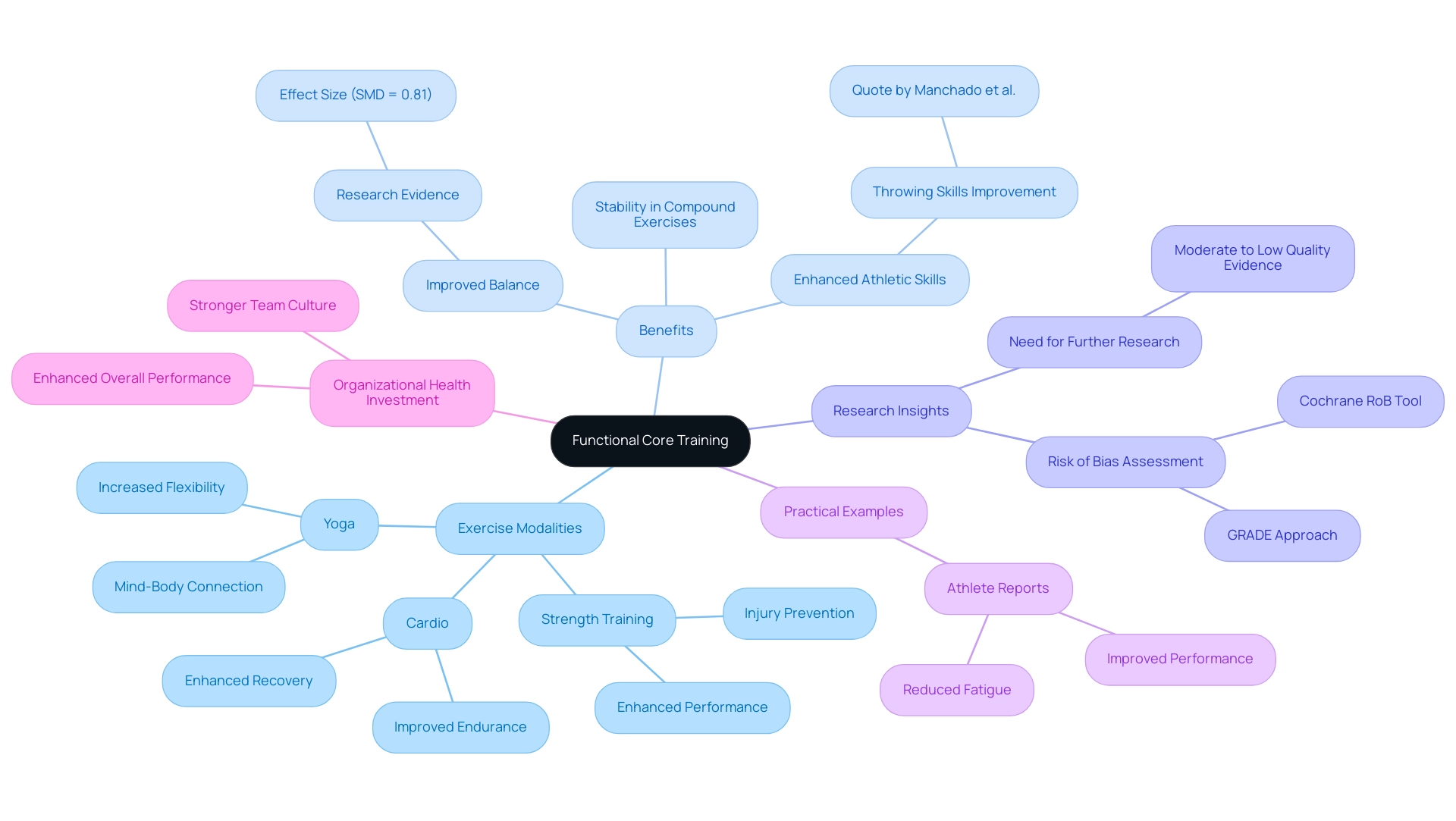
Conclusion
The exploration of functional core training underscores its pivotal role in enhancing overall fitness, stability, and injury prevention. By shifting the focus from traditional, isolated abdominal workouts to a more holistic approach, individuals engage their entire core, thereby improving performance in both athletic and everyday activities. This method not only fortifies the core but also promotes better posture, balance, and coordination—essential elements for maintaining a healthy lifestyle.
Debunking common myths surrounding core training is equally important. The belief that endless crunches will lead to visible abs or that spot reduction is achievable has hindered many from adopting effective training methods. Instead, a well-rounded fitness regimen that combines functional core exercises with a balanced diet is crucial for achieving desired results. Understanding that core training enhances athletic performance and reduces injury risk, rather than merely focusing on aesthetics, empowers individuals to optimize their workouts for long-term benefits.
Integrating functional core training into diverse fitness routines is both achievable and beneficial. Whether incorporated into strength training, cardio sessions, or yoga, core stability enhances the efficacy of various movements and fosters a more resilient body. As organizations recognize the value of employee wellness, promoting functional core workouts can lead to improved team performance and overall health.
In summary, functional abdominal workouts are not just a trend but a fundamental component of a comprehensive fitness strategy. By prioritizing core strength and stability, individuals unlock their potential, improve athletic abilities, and enhance daily performance, ultimately leading to a healthier and more active lifestyle.
Frequently Asked Questions
What is functional ab training?
Functional ab training emphasizes exercises that engage the entire midsection, including the abdominal muscles, obliques, and lower back, to enhance overall stability and strength. It focuses on movements that replicate real-life activities rather than isolating specific muscles.
How does functional ab training differ from traditional ab workouts?
Unlike traditional ab workouts that often isolate specific muscles, functional ab training incorporates movements that strengthen the foundation and improve posture, balance, and coordination, making it a key component of a comprehensive fitness regimen.
What are the benefits of stability exercises in functional ab training?
Stability exercises have been shown to significantly increase the thickness of central muscles, which enhances athletic performance and functional strength. They also yield substantial benefits in daily activities, improving tasks that require stability and strength.
Why is functional ab training particularly important for men over 50?
For men over 50, maintaining essential strength through functional ab training is crucial for preventing injuries and enhancing overall mobility.
How do athletes benefit from incorporating stability exercises into their routines?
Athletes who include stability exercises often experience significant improvements in jumping performance, which helps in both athletic achievement and daily physical activities.
What misconceptions exist about ab workouts?
Common misconceptions include the belief that endless crunches will yield visible abs and that spot reduction of fat is achievable. In reality, achieving a toned midsection requires overall fat reduction through diet and exercise, along with focused abdominal strengthening.
How should effective functional ab training be approached?
Effective functional ab training should prioritize stability and strength rather than just aesthetics. Traditional crunches may not be beneficial for building functional strength and can lead to unnecessary compression on spinal discs.
What role do inner muscles play in functional ab training?
Inner muscles are essential for providing stability and support to the body. Maintaining a strong inner foundation is crucial for overall health, facilitating proper breathing, and enhancing physical stability during balance and coordination activities.
What is the significance of including fundamental workouts in a fitness plan?
Including fundamental workouts enhances job performance, creativity, and stress management. It is essential for various demographics, including pregnant women, as it helps alleviate discomfort, improve posture, and enhance functional strength throughout pregnancy.

